Posts tagged ‘Teaspoon’
PCAS Expansion, Growth, Research, and SIGCSE 2024 Presentations
The ACM SIGCSE Technical Symposium is March 20-23 in Portland (see website here). I rarely blog these days, but the SIGCSE TS is a reminder to update y’all with what’s going on in the College of Literature, Science, & the Arts (LSA) Program in Computing for the Arts and Sciences (PCAS). PCAS is my main activity these days. Here’s the link to the PCAS website, which Tyrone Stewart and Kelly Campbell have done a great job creating and maintaining. (Check out our Instagram posts on the front page!)
PCAS Expansion
I’ve blogged about our first two courses, COMPFOR (COMPuting FOR) 111 “Computing’s Impact on Justice: From Text to the Web” and COMPFOR 121 “Computing for Creative Expression.” Now, we’re up to eight courses (see all the courses described here). As I mentioned at the start of PCAS, we think about computing in LSA in three themes: Computing for Discovery, Expression, and Justice. Several of these courses are collaborations with other departments, like our Discovery classes with Physics, Biophysics, Ecology and Evolutionary Biology, and Linguistics.
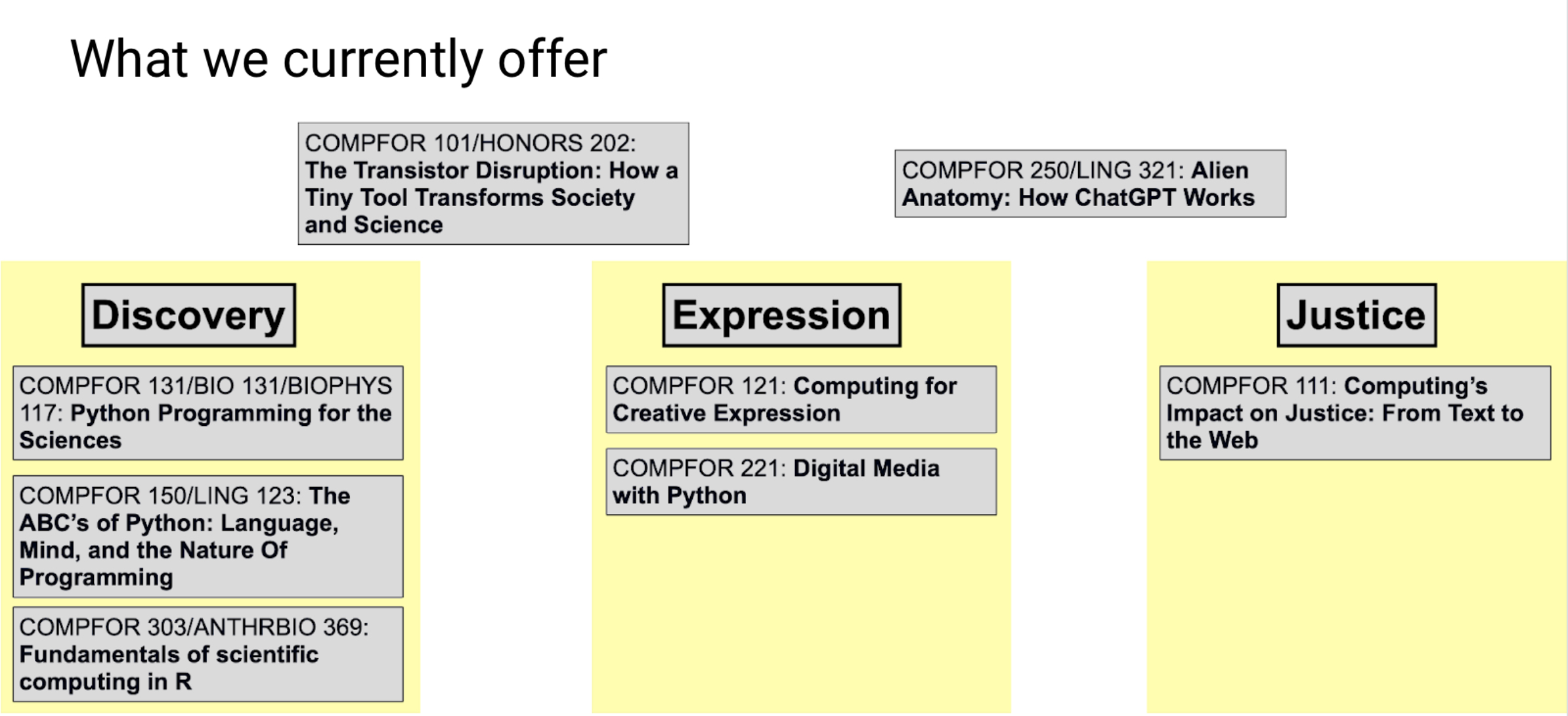
This semester, I’m teaching two brand new courses. That means that I’m creating them just ahead of the students. I did this in Fall 2022 for our first two courses (see links to the course pages here with a description of our participatory design process), and I hope to never do this again. It’s quite a sprint to always be generating material, all semester long, for about a hundred students.
One course is like the Media Computation course I developed at Georgia Tech, but in Python 3: COMPFOR 221: Digital Media with Python. The course title has changed. When we first offered it, we called it “Python Programming for Digital Media,” and at the end of registration, we had only five students enrolled! We sent out some surveys and found that we’d mis-named it. Students read “Python Programming” and skipped the rest. The class filled once we changed our messaging to emphasize Digital Media first.

When we taught Media Computation at Georgia Tech, we used Jython and our purpose-built IDE, JES. Today, there’s jes4py that provides the JES media API in Python 3. I had no idea how hard it was to install libraries in Python 3 today! I’m grateful to Ben Shapiro at U-W who helped me figure out a bunch of fixes for different installation problems (see our multi-page installation guide).
The second is more ambitious. It’s a course on Generative AI, with a particular focus on how it differs from human intelligence. We call it Alien Anatomy: How ChatGPT Works. It’s a special-topics course this semester, but in the future, it’ll be a 200-level (second year undergraduate) course with no pre-requisites open to all LSA students, so we’re relying on teaspoon languages and Snap! with a little Python. I’m team-teaching with Steve Abney, a computational linguist. Steve actually understands LLMs, and I knew very little. He’s been a patient teacher and a great partner on this. I’ve had to learn a lot, and we’re relying heavily on the great Generative AI Snap! projects that Jens Mönig has been creating, SciSnap from Eckart Modrow, and Ken Kahn’s blocks that provide an API to TensorFlow.
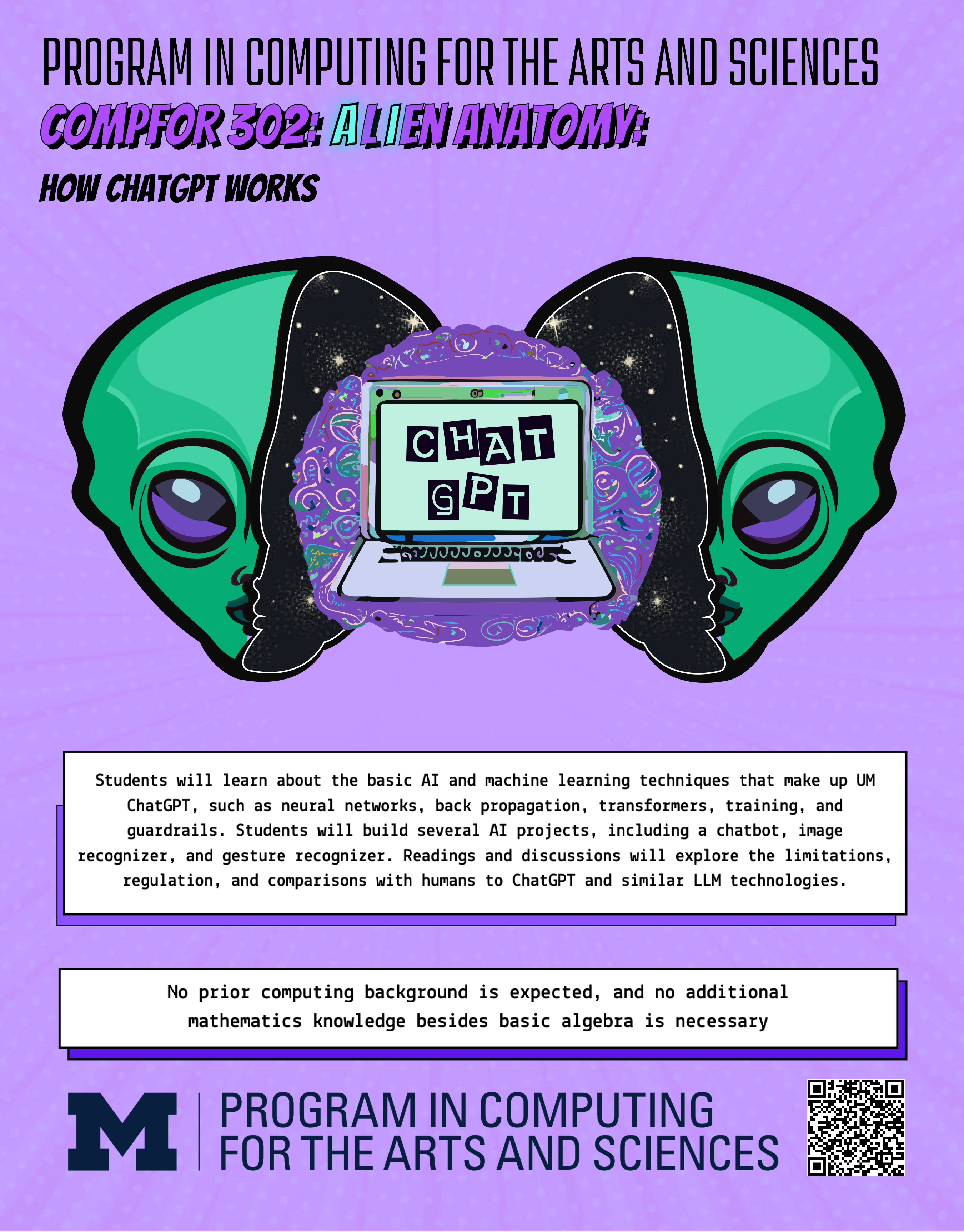
As of January, we are approved to offer two minors: Computing for Expression and Computing for Scientific Discovery. We have about a half dozen students enrolled so-far in the minors, which is pretty good for three months in.

PCAS Growth
When I offered the first two courses in Fall 2022, we had 11 students in Expression and 14 in Justice. Now, we’re up to 308 students enrolled. That’s probably our biggest challenge — managing growth and figuring out how to sustain it.
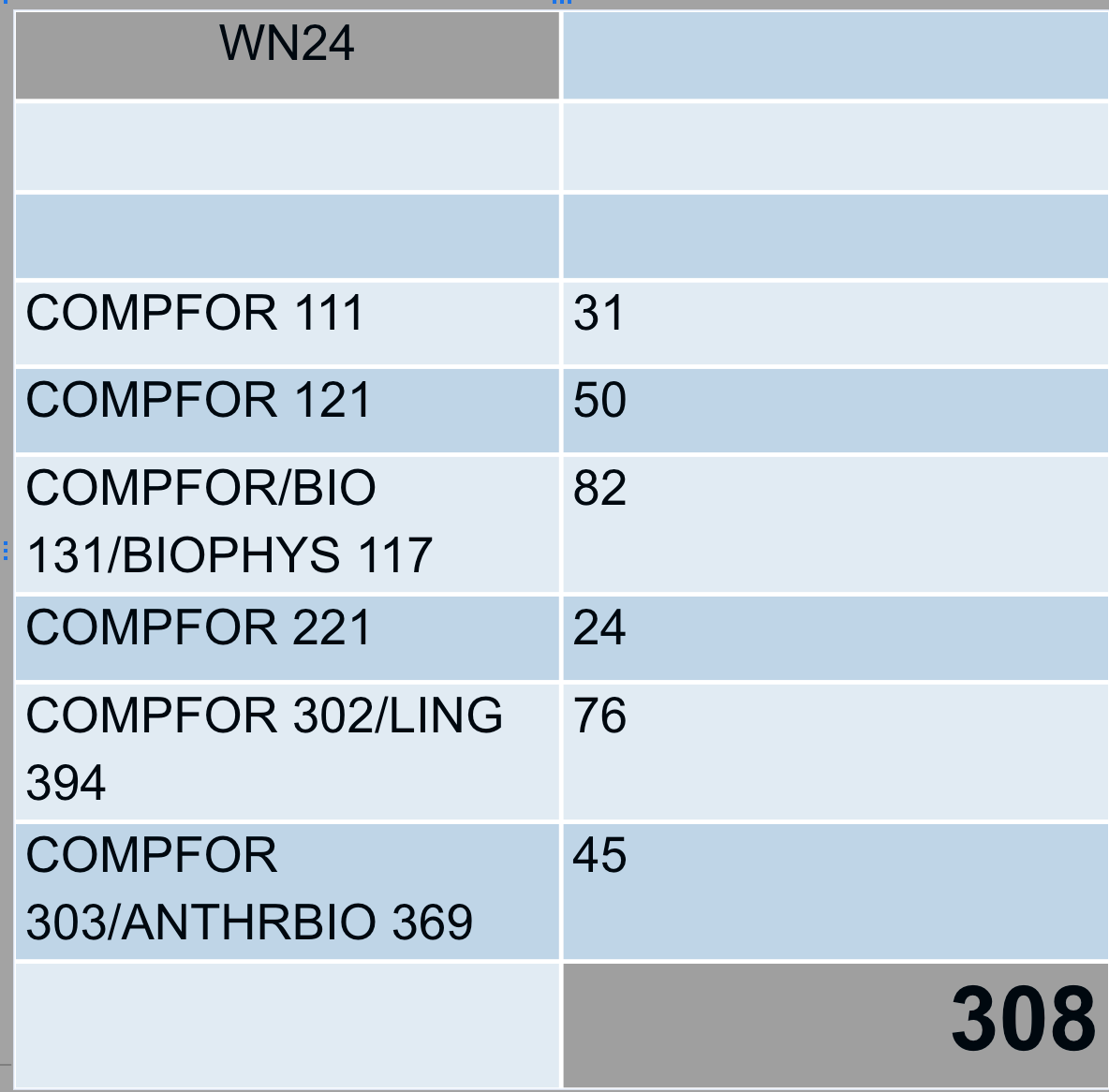
Research in PCAS
We’re starting to publish some of what we’re learning from PCAS. Last November, Gus Evrard and I published a paper at the Koli Calling International Conference on Computing Education Research about the process that we followed co-chairing the LSA Computing Education Task Force to figure out what LSA needed in computing education. That paper, Identifying the Computing Education Needs of Liberal Arts and Sciences Students, won a Best Discussion Paper Award. Here’s Gus and me at the conference banquet when we got our award.
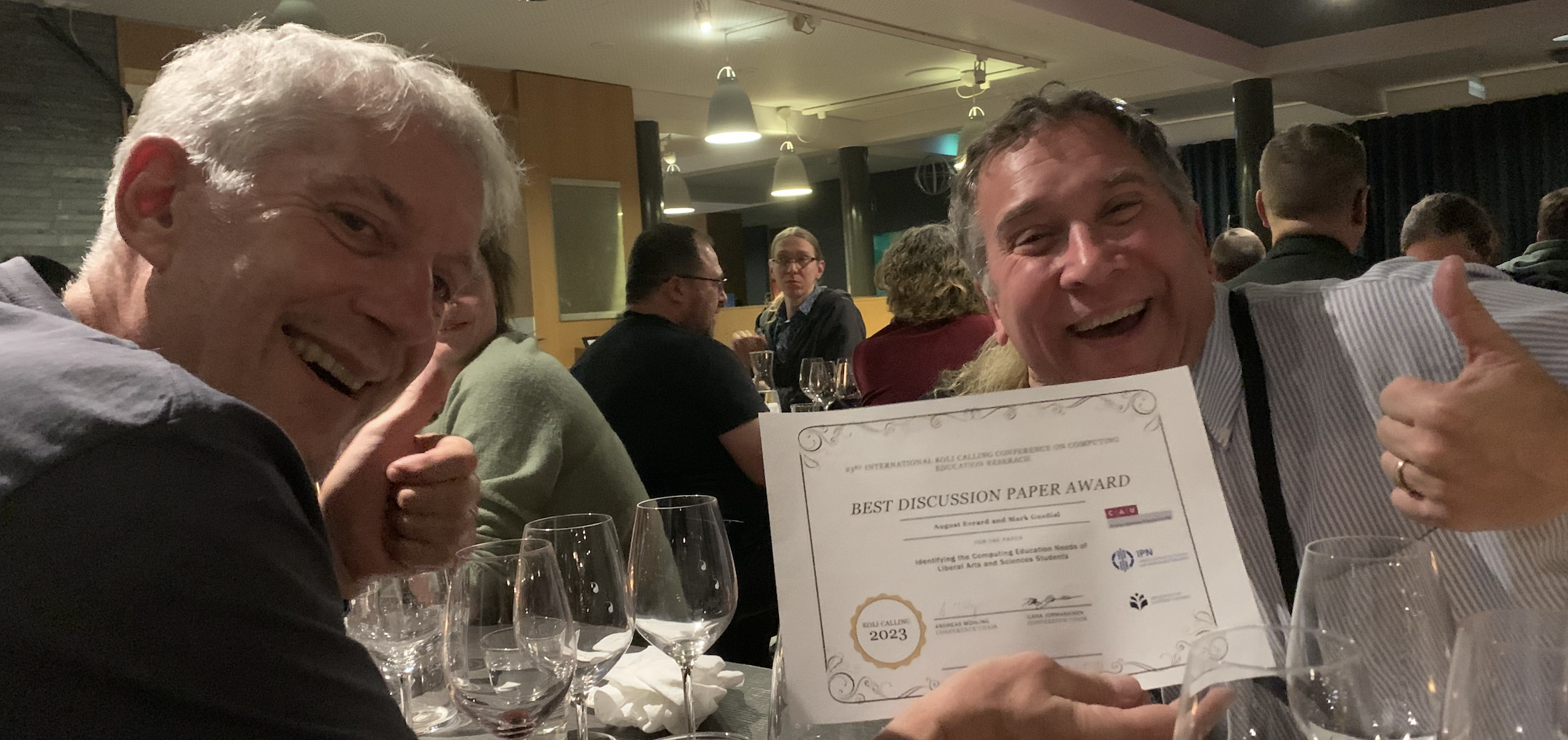
Tamara Nelson-Fromm just presented a paper at the 2024 PLATEAU Workshop on evidence we have suggesting transfer of learning from teaspoon languages into our custom Snap! blocks. I’ll wait until those papers are released to tell you more about that.
SIGCSE 2024 Presentations
We’re pretty busy at SIGCSE 2024, and almost all of our presentations are connected to PCAS.
Thursday morning, I’m on a panel led by Kate Lehman on “Re-Making CS Departments for Generation CS” 10:45 – 12:00 at Oregon Ballroom 203. This is going to be a hardball panel. Yes, we’ll talk about radical change, but be warned that Aman and I are on the far end of the spectrum. Aman is going to talk about burning down the current CS departments to start over. I’m going to talk about giving up on traditional CS departments ever addressing the needs of Generation CS (because they’re too busy doing something else) and that we need more new programs like PCAS. I’m looking forward to hear all the panelists — it’ll be a fun session.

Thursday just after lunch, Neil Brown and I are presenting our paper, Confidence vs Insight: Big and Rich Data in Computing Education Research 13:45 – 14:10 at Meeting Room D135. It’s an unusual computing education research paper because we’re making an argument, not offering an empirical study. We’re both annoyed at SIGCSE reviewers who ask for contextual information (Who were these students? What programming assignments were they working on? What was their school like?) from big (millions of points) data, and then complaining about small sample sizes from rich data with interviews, personal connections, and contextual information. In the paper, we make an argument about what are reasonable questions to ask about each kind of data. In the presentation, the gloves come off, and we show actual reviews. (There are also costumes.)
We don’t really get into why SIGCSE reviewers evaluate papers with criteria that don’t match the data, but I have a hypothesis. SIGCSE reviewers are almost all CS teachers, and they read a paper asking, “Does this impact how I teach? Does it tell me what I need to do in my class? Does it convince me to change?” Those questions are too short-sighted. We need papers that answer those questions to help us with our current problems, but we also need to have knowledge for the next set of problems (like when we start teaching entirely new groups of students). The right question for evaluating a computing education research paper is, “Does this tell the computing education research community (not you the reviewer, personally, based on your experience) something we didn’t know that’s worth knowing, maybe in the future?”
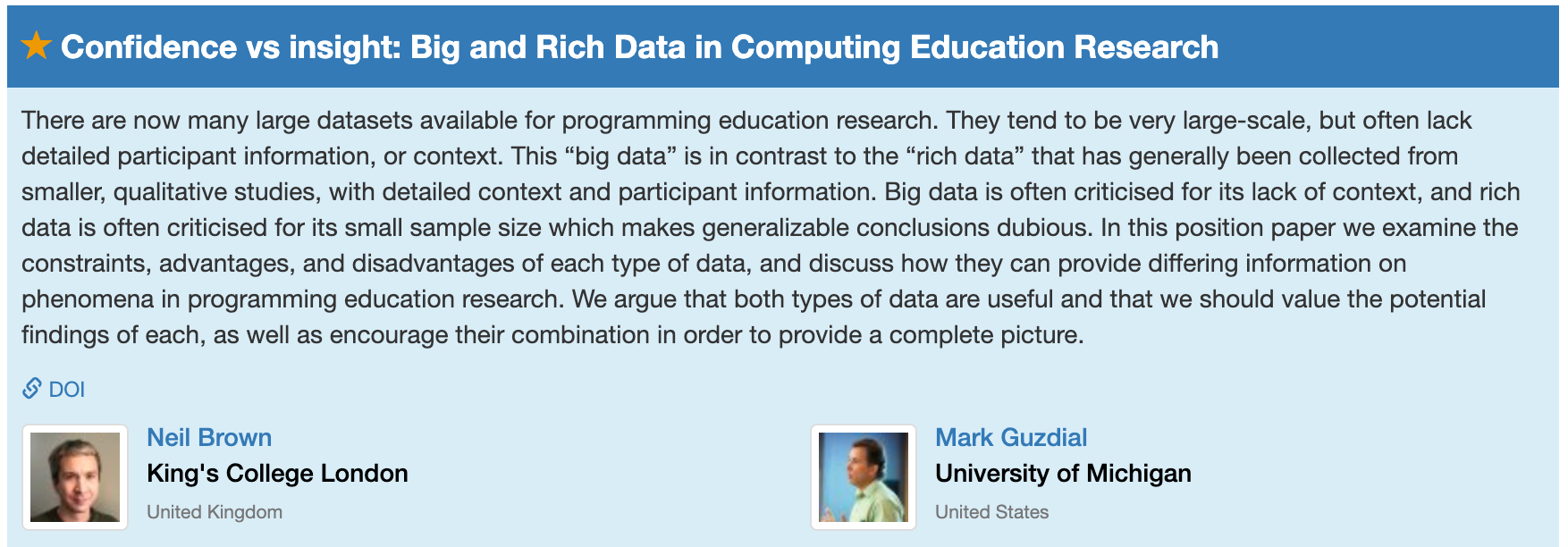
At the NSF Project Showcase Thursday 15:45 – 17:00 at Meeting Rooms E143-144, Tamara Nelson-Fromm is going to show where we are on our Discrete Mathematics project. She’ll demonstrate and share links to our ebooks for solving counting problems with Python and with one of our teaspoon languages, Counting Sheets.
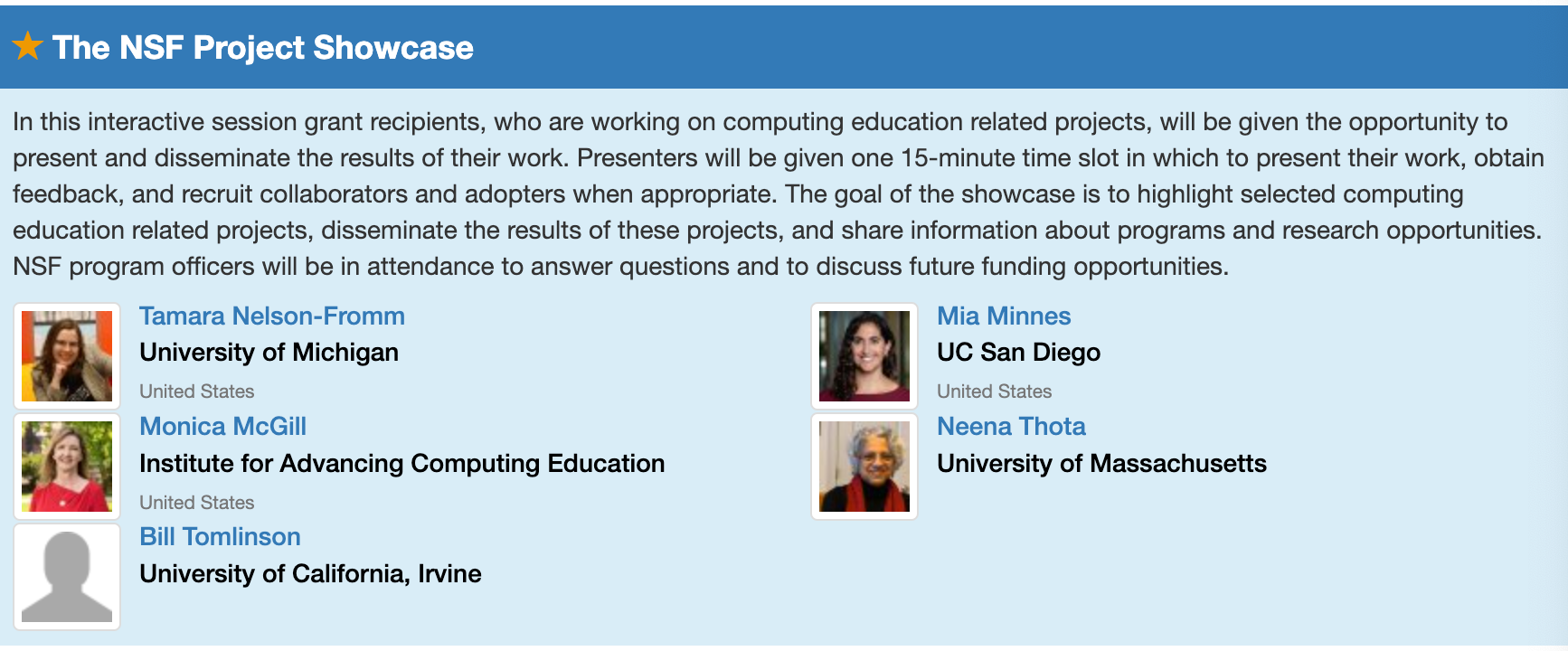
In the “second flock” of Birds of a Feather sessions Thursday 18:30 – 19:20 at Meeting Room D136, we’re going to be a part of Zach Dodd’s group on “Computing as a University Graduation Requirement”. There’s a real movement towards building out computing courses for everyone, not just CS majors, as we’re doing in PCAS. Zach is pushing further, for a general education requirement. I’m excited for the session to hear what everyone is doing.

On Saturday afternoon 15:30 – 18:30 at Meeting Rooms B113, I’ll offer a three-hour workshop on how we teach in our PCAS courses for arts and humanities students, with teaspoon languages, custom Snap! blocks, and ebooks. Brian Miller has been teaching these courses this year, and he’s kindly letting me share the materials he’s been developing — he’s made some great improvements over what I did. This workshop was inspired by a comment from Joshua Paley in response to our initial posts about how we’re teaching, where he asked if I’d do a SIGCSE workshop on how we’re teaching PCAS. Will do it on Saturday!

A Scaffolded Approach into Programming for Arts and Humanities Majors: ITiCSE 2023 Tips and Techniques Papers
I am presenting two “Tips and Techniques” papers at the ITiCSE 2023 conference in Turku, Finland on Tuesday July 11th. The papers are presenting the same scaffolded sequence of programming languages and activities, just in two different contexts. The complete slide deck in Powerpoint is here. (There’s a lot more in there than just the two talks, so it’s over 100 Mb.)
When I met with my advisors on our new PCAS courses (see previous blog post), one of the overarching messages was “Don’t scare them off!” Faculty told me that some of my arts and humanities students will be put off by mathematics and may have had negative experiences with (or perceptions of) programming. I was warned to start gently. I developed this pattern as a way of easing into programming, while showing the connections throughout.
The pattern is:
- Introduce computer representations, algorithms, and terms using a teaspoon language. We spend less than 10 minutes introducing the language, and 30-40 minutes total of class time (including student in-class activities). It’s about getting started at low-cost (in time and effort).
- Move to Snap! with custom blocks explicitly designed to be similar to the teaspoon language. We design the blocks to promote transfer, so that the language is similar (surface level terms) and the notional machine is similar. Students do homework assignments in Snap!.
- At the end of the unit, students use a Runestone ebook, with a chapter for each unit. The ebook chapter has (1) a Snap! program seen in class, (2) a Python or Processing program which does the same thing, and (3) multiple choice questions about the text program. These questions were inspired by discussions with Ethel Tshukudu and Felienne Hermans last summer at Dagstuhl where they gave me advice on how to promote transfer — I’m grateful for their expertise.
I always teach with peer instruction now (because of the many arguments for it), so steps 1 and 2 have lots of questions and activities for students throughout. These are in the talk slides.
Digital Image Filters
The first paper is “Scaffolding to Support Liberal Arts Students Learning to Program on Photographs” (submitted version of paper here). We use this unit in this course: COMPFOR 121: Computing for Creative Expression.
Step 1: The teaspoon language is Pixel Equations which I blogged about here. You can run it here.
Students choose an image to manipulate as input, then specify their image filter by (a) writing a logical expression describing the pixels that they want to manipulate and (b) writing equations for how to compute the red, green, and blue channels for those pixels. Values for each channel are 0 to 255, and we talk about single byte values per channel. The equation for specifying the channel change can also reference the previous values of the channels, using the variables red, green, blue, rojo, verde, or azul.
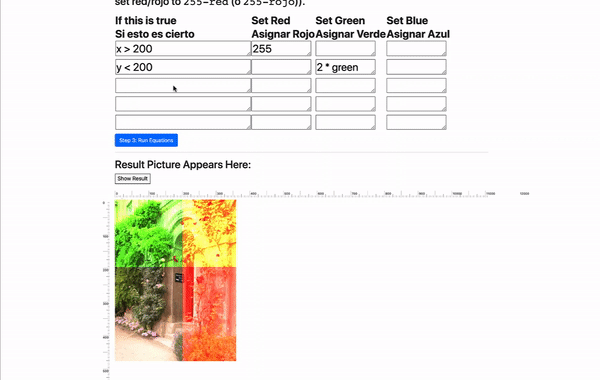
Step 2:The latest version of the pixel microworld for Snap is available here. Click See Code to see all the examples — I leave lots of worked examples in the projects, as a starting point for homework and other projects.
Here’s what negation looks like:

Here’s an example of replacing a green background with the Alice character so that Alice is standing in front of a waterfall.


The homework assignment here involves creating their own image filters, then generate a collage of their own images (photos or drawn) in their original form and filtered.
Step 3:The Runestone ebook chapter on pixels is here.

Questions after the Python code include “Why do we have the for loop above?” And “What would happen if we changed all the 255 values to 120? (Yes, it’s totally fair to actually try it.)”
Recognizing and Generating Human Language
The second paper is “Scaffolding to Support Humanities Students Programming in a Human Language Context” (submitted version here). I originally developed this unit for this course COMPFOR 111: Computing’s Impact on Justice: From Text to the Web because we use chatbots early on in the course. But then, I added chatbots as an expressive medium to the Expression course, and we use parts of this unit in that course, too.
Step 1: I created a little teaspoon language for sentence recognition and generation — first time that I’ve created a teaspoon language with me as the teacher, because I needed one for my course context. The language is available here (you switch between recognition and generation from a link in the upper left corner).
The program here is a sentence model. It can use five words: noun, verb, adverb, adjective, and article. Above the sentence model is the dictionary or lexicon. Sentence generation creates 10 random sentence from the model. Sentence recognition also takes an input sentence, then tries to match the elements in the model to the input sentence. I explain the recognition behavior like this:
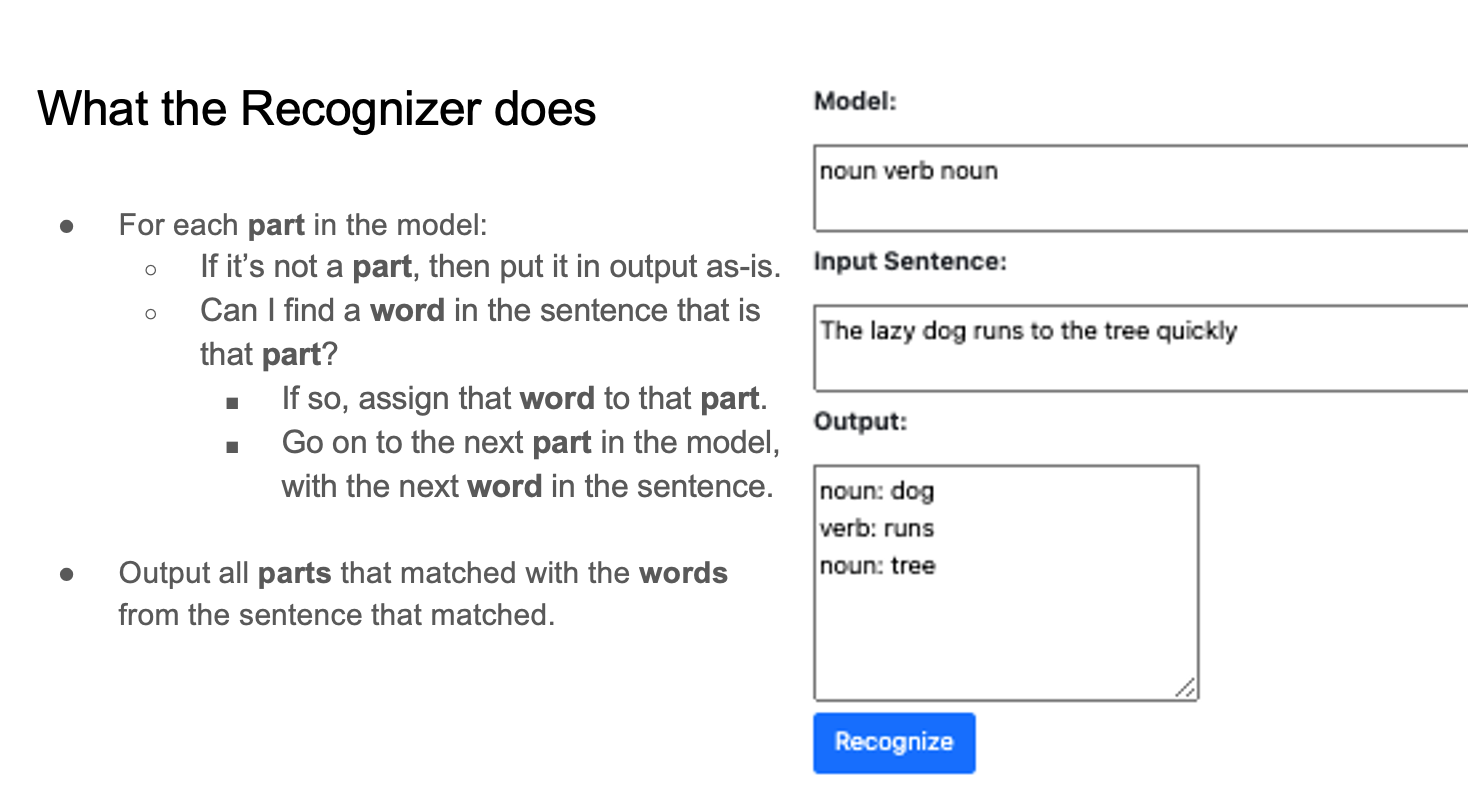
This is very simple, but it’s enough to create opportunities to debug and question how things work.
- I give students sentences and models to try. Why is “The lazy dog runs to the student quickly” recognized as “noun verb noun” but “The lazy dog runs to the house quickly” not recognized? Because “house” isn’t in the original lexicon. As students add words to the lexicon, we can talk about program behavior being driven by both algorithm and data (which sets us up for talking about the importance of training data when creating ML systems later).
- I give them sentences in different English dialects and ask them to explore how to make models and lexicons that can match all the different forms.
- For generation, I ask them: Which leads to better generated sentences? Smaller models (”noun verb”) or larger models (“article adjective noun verb adverb”)? Does adding more words to the lexicon? Or tuning the words that are in the lexicon?
Step 2: Tamara Nelson-Fromm built the first set of blocks for language recognition and generation, and I’ve added to them since. These include blocks for language recognition.


And language generation.


The examples in this section are fun. We create politically biased bots who tweet something negative about one party, listen for responses about their own party, then say something positive in retort about their party.

We create scripts that generate Dr. Seuss like rhymes.

The homework in this section is to generate haiku.
Step 3: The Runestone ebook chapter for this unit is here. The chapter starts out with the sentence generator, and then Snap! blocks that do the same thing, and then two different Python programs that do the same thing. We ask questions like “Which of the following is a sentence that could NOT be produced from the code above?” And “Let’s say that you want to make it possible for to generate ‘A curious boat floats.’ Which of the lines below do you NOT have to change?”

Where might this pattern be useful?
We don’t use this whole three-step pattern for every unit in these classes. We do something similar for chatbots, but that’s really it. Teaspoon languages in these classes are about getting started, to get past the “I like computers. I hate coding” stage (as described by Paulina Haduong in a paper I cite often). We use the latter two steps in the pattern more often — each class has an ebook with four or five chapters. The Snap to Python steps are about increasing the authenticity for the block-based programming and developing confidence that students can transfer their knowledge.
I developed this pattern to give non-STEM (arts and humanities) students a gradual, scaffolded approach to program, but it could be useful in other contexts:
- We originally developed teaspoon languages for integrating computing into other subjects. The first two steps in this process might be useful in non-CS classes to create a path into Snap programming.
- The latter two steps might be useful to promote transfer from block-based into textual programming.
Putting a Teaspoon of Programming into Other Subjects (May 2023 Communications of the ACM): About Teaspoon Languages
In May, my students and I published a paper in Communications of the ACM, “Putting a Teaspoon of Programming into Other Subjects” (see link here) about our work with teaspoon languages. (Submitted version, non-paywalled is here.) It’s a short Viewpoint, but we were able to squeeze into our 1800 word limit description of a couple of teaspoon languages, a definition of them, a description of our participatory design process for them, and some of the research questions we’re exploring with them, like what drives teacher adoption of teaspoon languages, use multilingual keywords to engage emerging bilingual students, and identifying challenges to even our simplified notions of programming.
My students helped me to be consistent with our language in this piece, which was so helpful. I’ve been talking about teaspoon languages for awhile, and my language has likely changed over that time. They’re challenging me to be more exact about what I mean.
For example, we use the phrase “teaspoon languages” and not “teaspoon programming languages.” The term “teaspoon” comes from the shorthand “TSP” for “Task-Specific Programming.” So, the “programming” bit is already in there. But in particular, I don’t want to generate the reaction, “But, hey, that doesn’t look like a real programming language…”
Programming languages are used to create software — preferably, software that is reliable, robust, safe, and secure. The programming languages research community works to make programming more effective for people who are using those languages to create software. Programming as an activity can also be used to solve problems and explore domains. We’re building languages for that latter purpose. Much of the programming that scientists and others do to solve problems and explore domains happens to be in programming languages that can also be used to create software (e.g., Python, R, Mathematica, MATLAB). Teaspoon languages (so far) can’t really be used to create software for someone else to execute. They’re not general. I don’t think any of the teaspoon languages that we have created are Turing complete. But teaspoon languages are used to define the behavior of a computational agent. It’s still programming.
Another question we hear quite a bit is “Isn’t this just a domain-specific language?” We tried to answer that in the piece. Yes, teaspoon languages are a kind of domain-specific language, but for a very small domain — a single task. The most critical part of teaspoon languages is “They can be used by students for a task that is useful to a teacher.” DSLs are so much bigger than teaspoon languages. Maybe we can use DSL tools one day to make teaspoon languages, but so-far, we’ve built unique user interfaces and unique languages for each one. The focus is on meeting the need now, and we’ll see if we ever get to generalizability and tools later.
The issues we study in our research with teaspoon languages don’t have much overlap with the programming languages research community. I don’t have good answers to questions like, “How do you support type safety?” or “Why can’t I define a lambda in Pixel Equations?” So, we’ll just call them “teaspoon languages” — and let the “programming” word be silent in there.
Participatory Design to Support University to High School Curricular Transition/Translation in FIE 2022
Here’s my second blog post on papers we presented during the first year of PCAS. Emma Dodoo is an Engineering Education Research PhD student working with me and co-advised with Lisa Lattuca. When she first started working with me, she wanted a project that supported STEM learning in high school. We happened upon this fascinating project which eventually led to an FIE 2022 paper (see link here).
The University of Michigan Marsal Family School of Education has a collaboration with the School at Marygrove in the Detroit Public Schools – Community District. The School at Marygrove requires all high school students to take a course in Engineering every year. The school is new, so when we came into the story, they were just starting to build an 11th grade Engineering curriculum. Where does an innovative K-12 school find curriculum for not-often-taught subjects like Engineering? It seemed natural to look to the partner university.
The University of Michigan has recently established a Robotics Department with an innovative undergraduate curriculum. The leadership in the U-M School of Education and the School at Marygrove decided to use some projects from the undergraduate curriculum for the 11th grade Engineering curriculum. Emma and I came in to run participatory design sessions to help with supporting the high school in adopting the university curriculum. We focused on one project in particular, where students would input data from a LIDAR sensor on a robot, then visualize the results. What we wanted to know was: What are the issues that come up when using a university curriculum to inform an innovative high school curriculum?
We started out with a set of interviews. We talked to undergraduates who had been in the Robotics curriculum and asked them: What was hard about the robotics projects? What were things that you wished you knew before you started? They gave us a list of issues, like the realization that equations on a plane could be used to define regions of a picture, that colors could be mapped to numbers and equations, and that pixels could be queried for their colors.
We talked to high school educators about what they wanted students to learn from the project. They were pretty worried about the mathematics required for the project, especially after the students had spent all of 10th grade on-line during the pandemic.
Emma took these objectives and concerns, and generated a set of possible activities to be used in the class. She used Desmos, Geogebra, and our new Pixel Equations teaspoon language. (I mentioned back in this blog post that we were using Pixel Equations in participatory design sessions — that’s when this study was happening.)
Pixel Equations was developed explicitly for the concerns that the undergraduates were raising and that the math educators cared about. Users specify the pixels they want to manipulate (leftmost column) by providing an equation on a plane or an equation based on the RGB channels in the color in the pixel. They specify the desired color changes in terms of the red, green, and blue channels (three columns on the right). The syntax for the boolean expressions and the equations for calculating colors is the same as what students would see in Java, C, or JavaScript. But there are no explicit loops, conditionals, or data — it’s a teaspoon language.

Emma ran participatory design sessions with stakeholders, including teachers from the School at Marygrove. Her goal was to identify the features that the stakeholders would find valuable, and in particular, to identify the concerns of the high school educators that may not be addressed in the university curriculum. She identified four sets of issues that were important to the stakeholders when transferring curriculum from the university to the high school:
- Prior Knowledge: The students knew Desmos. Using a tool they used before would help a lot when dealing with the new robotics concepts.
- Priming: The computing must be introduced so that there is time for the students to become familiar with it.
- Motivational Play: High school students need more opportunities to see the fun in an activity than undergraduate students.
- Self-efficacy: It’s important for students to feel that they can succeed at the activities.
That’s where the paper ends
All of this design and development happened during the pandemic. We didn’t hear much about what was going on in the high school, and we couldn’t visit. When we talked to our contacts at the School of Education, we found that they didn’t have much news either. It wasn’t until much later that we saw this news item. The 11th grade Engineering class actually didn’t do any of the mathematics activities that we’d helped with. Instead, the school got a grant for a bunch of robots, and the classes focused on directly programming the robots instead. It’s disappointing that they didn’t use any of the things that we worked on, but as I’ve been mentioning in this blog, we find that adoption is really hard. Other factors (like grants and the wow factor of programming a robot) can change priorities.
The paper is interesting for investigating stakeholder issues when transferring activities from university to high schools. Those are useful issues to know about, but even if you address all the issues, you still might not get adoption.
Getting feedback on Teaspoon Languages from CS educators and researchers at the Raspberry Pi Foundation seminar series
In May, I had the wonderful opportunity to speak at the Raspberry Pi Foundation Seminar series. I’ve attended some of these seminars before. I highly recommend them (see past seminars here). It’s a terrific format. The speaker presents for up to a half hour, then everyone gets put into a breakout room for small group discussions. The participants and speaker come back for 30-35 minutes of intensive Q&A — at least, it feels “intensive” from the speaker’s perspective. The questions you get have been vetted through the breakout room process. They’re insightful, and sometimes critical, but always in a constructive way. I was excited about this opportunity because I wanted to make it a hands-on session where the CS teachers and researchers who attended might actually use some Teaspoon Languages and give me feedback on them. I have rarely had the opportunity to work with CS teachers, so I was excited for the opportunity.
Sue Sentance wrote up a very nice blog post describing my talk (thank you!) — see here. The video of the talk and discussion is available. You can watch the whole thing, or, you can read the blog post then skip ahead to where the conversation takes place (around 26:00 in the video). If you have been wondering, “Why isn’t Mark just using Logo, Scratch, Snap, or NetLogo? We already have great tools! Why invent new languages that are clearly less powerful than what we already have?”, then you should jump to 34:38 and see Ken Kahn (inventor of ToonTalk) push me on this point.
The whole experience was terrific for me, and I hope that it’s valuable for the viewer and attendees as well. The questions and comments indicated understanding and appreciation for what I’m trying to do, and the concerns and criticisms are valuable input for me and my team. Thanks to Sue, Diana Kirby, the Raspberry Pi Foundation, and all the attendees!
Updates: Dr. Barbara Ericson awarded ACM SIGCSE 2022 Outstanding Contributions to Education
March 2-5 is the ACM SIGCSE Technical Symposium for 2022 in Providence, RI. (Schedule is here.) I am absolutely thrilled that my collaborator, co-author, and wife is receiving the Outstanding Contributions to Education award! She is giving a keynote on Friday morning. Her abstract is below.
She’s got more papers there, on CS Awesome, on her ebooks, and on Sisters Rise Up. I’m not going to summarize them here. I’ll let you look them up in the schedule.
A couple of observations about the SIGCSE Awards this year that I love. Both Barb and the Lifetime Service to the Computer Science Education Community awardee, Simon, earned their PhD’s later in life, both within the last 10 years. Barb is the first Assistant Professor to win the Outstanding Contributions award in the 40 year history of the award.
I have one Lightning Talk. The work I’m doing these days is computing education, but it’s not in the mainstream of CS education — I focus on computing education for people who don’t want to study CS. So, I’m doing a five minute lightning talk on Teaspoon languages as provocation to come talk to me about this approach to integrating computing into non-CS subjects. You can see the YouTube version here. This is my attempt to show that each Teaspoon language can be learned in 10 minutes — I describe all of two of them in less than five minutes!
Outstanding Contribution Plenary
Friday, March 4 / 8:15 – 9:45
Ballroom A-E (RICC)
Barbara Ericson (University of Michigan)
Improving Diversity in Computing through Increased Access and Success
My goal is to increase diversity in computing. In this talk I explain why diversity is important to me. My strategy to improve diversity is to increase access and success. This work includes teacher professional development, summer camps, weekend workshops with youth serving organizations, curriculum development, helping states make systemic changes to computing education, publicizing gender and race issues in Advanced Placement Computer Science, creating free and interactive ebooks, testing new types of practice problems/tools, and offering near-peer mentoring programs.
Barbara Ericson is an Assistant Professor in the School of Information at the University of Michigan. She conducts research at the intersection of computing education, the learning sciences and HCI, to improve students’ access to and success in computing. With her husband and colleague, Dr. Mark Guzdial, she received the 2010 ACM Karl V. Karlstrom Outstanding Educator Award for their work on media computation. She was the 2012 winner of the A. Richard Newton Educator Award for her efforts to attract more females to computing. She is also an ACM Distinguished Member for Outstanding Educational Contributions to Computing.
Updates: NSF Funding to Study Learning with Teaspoon Languages for Discrete Mathematics
A few months before the pandemic started, Dr. Elise Lockwood at Oregon State reached out to me. She’d heard that I was interested in programming for teaching non-CS subjects, and that’s what she was doing. I loved what she was doing, and we started having regular chats.
Elise is a mathematics education researcher who has been studying how students come to understand counting problems. Like “If you have three letters and four digits, how many license plates can you make?” Or “How many two letter words can you make from the letters ROCKET, if you don’t allow double letters?” She’s been exploring having students learn counting problems by manipulating Python programs to generate all the possible combinations, then counting them. (Check out her recent papers on her Google Scholar page, especially those with her student Adaline De Chenne.)
As I said, I loved what she was doing, but Python seemed heavy-handed for this. I was starting to work on our Teaspoon languages. Could we build lighter-weight languages for the same problems?
As I kept reading Elise’s papers, I started working on two possible designs.
In one of them (called Counting Sheets), we play off of students’ understanding of spreadsheets. You can just describe what you want in each column, and the system will exhaustively generate every combination:

Or you can use an “=“ formula that knows how to do very simple operations with sets. Here’s a solution to the two letter words from ROCKET without repeating problem:

This is one of the tools that we’ve been building in support for both Spanish and English keywords (like Pixel Equations, that I talked about last September):

Elise found Counting Sheets intriguing, but she was worried if it would work to make the iterative structures implicit and declarative. Would students need to see the iteration to be able to reason about the counting processes?
So, I built a second Teaspoon language, called Programmed Counting. Here, the loops are explicit, like Python, but the only variable type is a set, and the words and phrases of the language come from counting problems.

Elise was a real sport, trying out the languages as I generated prototypes and finding the holes in what I was doing. We met face-to-face only once, when I went to Portland for SIGCSE 2020 — the one that got cancelled the very morning it was supposed to start. I had lunch with Elise, and we worked for a few hours on the designs. Barb and I went home the next day, and the big pandemic lockdown started right afterwards.
Will these work for learning? We don’t know — but we just got funding from NSF to find out! “We” here is me and PhD student Emma Dodoo, and we’ll be involving Adaline as a consultant. Elise is currently a rotator at NSF, so she’s involved only from the sidelines because of NSF COI issues. Our plan is to run experiments with various combinations of the Teaspoon languages (one or both), standalone and with Python. Do we need Python if we have the Teaspoon languages? Do the Teaspoon languages serve as scaffolding to introduce concepts before starting into Python?
Below is the abstract on the new IUSE grant, as an overview of the project. University of Michigan CSE Communications wrote a nice article about the work, available here. Huge thanks to Jessie Houghton, Angela Li, and Derrick White who turned my LiveCode prototypes into functioning Web versions.
Abstract for NSF
Programming is a powerful tool that scientists, engineers, and mathematicians use to gain insight into their problems. Educators have shown how programming integrated into other subjects can be a powerful tool to enhance learning, from algebra to language arts. However, the cost is learning the programming language. Few students in the US learn programming — less than 5% of high school students nationwide. Most students do not have the opportunity to use programming to support ™ learning. This project is investigating a new approach to designing and implementing programming languages in classrooms: Task-specific programming (TSP) languages. TSP languages are explicitly design for integration in specific classes, to meet teacher needs, and to be usable with less than 10 minutes of instruction. TSP languages can make the power of programming to enhance learning more accessible. This project will test the value of TSP languages in discrete mathematics, which is a gateway course in some computer science programs.
The proposed project tests the use of two different TSP languages and contrasting that with a traditional programming language, Python. The proposed work will contribute to understanding about (1) the role of programming in learning in discrete mathematics, (2) the value of task-specific languages to scaffold learning, (3) how alternative representational forms for programming influence student use of TSP languages, and (4) how the use of TSP languages alone or in combination with traditional languages enhance students’ sense of authenticity and ability to transfer knowledge.
Helping social studies teachers to teach data literacy with Teaspoon languages
Last year, Tammy Shreiner and I received NSF funding to develop and evaluate computational supports for helping social studies teachers to teach data literacy and computing(see post here). We’re excited about what we’re doing and what we’re learning. Here’s an update on where we’re at on the project.
Teaspoon Languages
We have a chapter in the new book by Aman Yadav and Ulf Dalvad Berthelsen Computational Thinking in Education: A Pedagogical Perspective. This is the publication where we introduce the idea of Teaspoon Languages. Teaspoon languages are a form of task-specific languages (TSP => Teaspoon — see?). Teaspoon languages:
- Support learning tasks that teachers (typically non-CS teachers) want students to achieve;
- Are programming languages, in that they specify computational processes for a computational agent to execute; and
- Are learnable in less than 10 minutes, so that they can be learned and used in a one hour lesson. If the language is never used again, it wasn’t a significant learning cost and still provided the benefit of a computational lesson.
We say that we’re adding a teaspoon of computing to other subjects. The goal is to address the goal of “CS for All” by integrating computing into other subjects, by placing the non-CS subjects first. We believe that programming can be useful in learning other subjects. Our primary goal is to meet learning objectives outside of CS using programming. Teachers (and students eventually) will be learning foundational CS content — but not necessarily the content we typically teach in CS classes. All students should learn that a program is non-WYSIWYG, that it’s a specification of a computational process that gets interpreted by a computational agent, that programming languages can be in many forms, and that all students can be successful at programming.
Our chapter, “Integrating Computing through Task-Specific Programming for Disciplinary Relevance: Considerations and Examples” (see link here) offers two use cases of how we imagine teaspoon languages to work in classrooms (history and language arts in these examples). The first use case is around DV4L, our Data Visualization for Learning tool. The second is around a chatbot language that we developed —- and have long since discarded.
We develop our teaspoon languages in a participatory design process, where teachers try our prototypes in authentic tasks as design probes, and then they tell us what we got wrong and what they really want. Our current iteration is called Charla-bots and is notable for having user-definable languages. We have a variety of Charla-bot languages now, with English, Spanish, and mixed keywords.
Our vision for teaspoon languages is a contrast with the “Hour of Code” approach. The “Hour of Code” is a one hour programming activity that many schools use in every grade, typically once a year during CS Ed Week (in early December). The great idea is to build familiarity and confidence in programming by showing students real computer science every year. The teaspoon languages approach is to imagine one or two little learning programming activity in every social studies, language arts, and mathematics class every year. Each of these languages is tiny and different. The goal is that by the time that US students take a CS class (typically, in high school or undergraduate), they will have had many programming experiences, have seen a variety of types of programming languages, and have a sense that “programming isn’t hard.”
Meeting the Needs of Social Studies Teachers
The second paper, “Using Participatory Design Research to Support the Teaching and Learning of Data Literacy in Social Studies” (see link here) was just presented in October by Tammy at CUFA, the College and University Faculty Assembly 2021 of the National Council of the Social Studies. (We have a longer form of this paper that we have just submitted to a journal.) This is an exciting paper for me because it’s exactly addressing the critical challenge in our work. We can design and implement all kinds of prototype Teaspoon languages, but to achieve our goals, teachers in disciplines other than CS have to see value and adopt them.
The paper is about our workshops with practicing social studies teachers. Tammy has a goal to teach social studies teachers how to teach data literacy. She has built a large online education resource (OER) on teaching data literacy in social studies. Learning data literacy involves being able to read, comprehend, and argue with data visualizations, but also being able to create them. That’s where we come in. Her OER links to several tools for creating data visualizations, like Timeline JS, CODAP, and GapMinder. Most of them were not created for social studies teachers or classes. When we run these workshops, our tools are just in-the-mix. We offer scaffolding for using all of them. These are our design probes. The teachers use the tools and then tell us what they really want. These are our data, and we analyze them in detail —- as in this paper.
Let’s jump to the bottom line: We’re not there yet. The teachers love the OER, but get confused about why should do in their classes. They find the tools for data visualization fascinating, but overwhelming. They like DV4L a lot:
One pre-service teacher explained that they preferred our prototype over other tools because “(with the prototype DV4L) I found myself asking questions connected to the data itself, rather than asking questions in order to figure out how to work the visual.”
Recently, I held a focus group with some social studies teachers who told me that they won’t use any computational tools —- they believe in teaching data visualization, but all created with pencil and ruler. That’s our challenge: Can we be more powerful, more enticing, and easy enough to beat out pencil and ruler? Our tool, DV4L, is purpose-built for these teachers, and they appreciate its advantages — and yet, few are adopting. That’s where we need to work next.
Opportunities for Social Studies Teachers to Get Involved
If you know a social studies teacher who would want to keep informed about our work and perhaps participate in our workshops or studies, please have them sign up on our mailing list. Thank you!
Often, what teachers tell us they really want suggests new features or entirely new tools. We have two ongoing studies where we are looking for design feedback from social studies teachers. If you know social studies teachers who would like to play with something new (and we’ll pay them for their time), would you please forward these to them?
Timeline Builder
We’re looking for K-12 Social Studies teachers to try out our new timeline visualization tool, TimelineBuilder. TimelineBuilder has been made with teachers and usability in mind. In it, ‘events’ are added to a timeline using a form-based interface. Changes to the timeline can be seen automatically, with events showing up as soon as they are added.
This study will consist of completing 2 surveys and 3 asynchronous activities guided by worksheets. All participants will be compensated with a $20 gift card for survey and activity completion. There is an additional option to be invited to a focus group, which will provide additional compensation.
If you are interested in participating in this study, you can complete the consent form and 1st survey here. (Plain text Link: https://forms.gle/gwxfn5bRgTjyothF6 )
Please contact Mark Guzdial (mjguz@umich.edu) or Tamara Nelson-Fromm (tamaranf@umich.edu) with any questions.
The University of Michigan Institutional Review Board Health Sciences and Behavioral Sciences has determined that this study is exempt from IRB oversight.
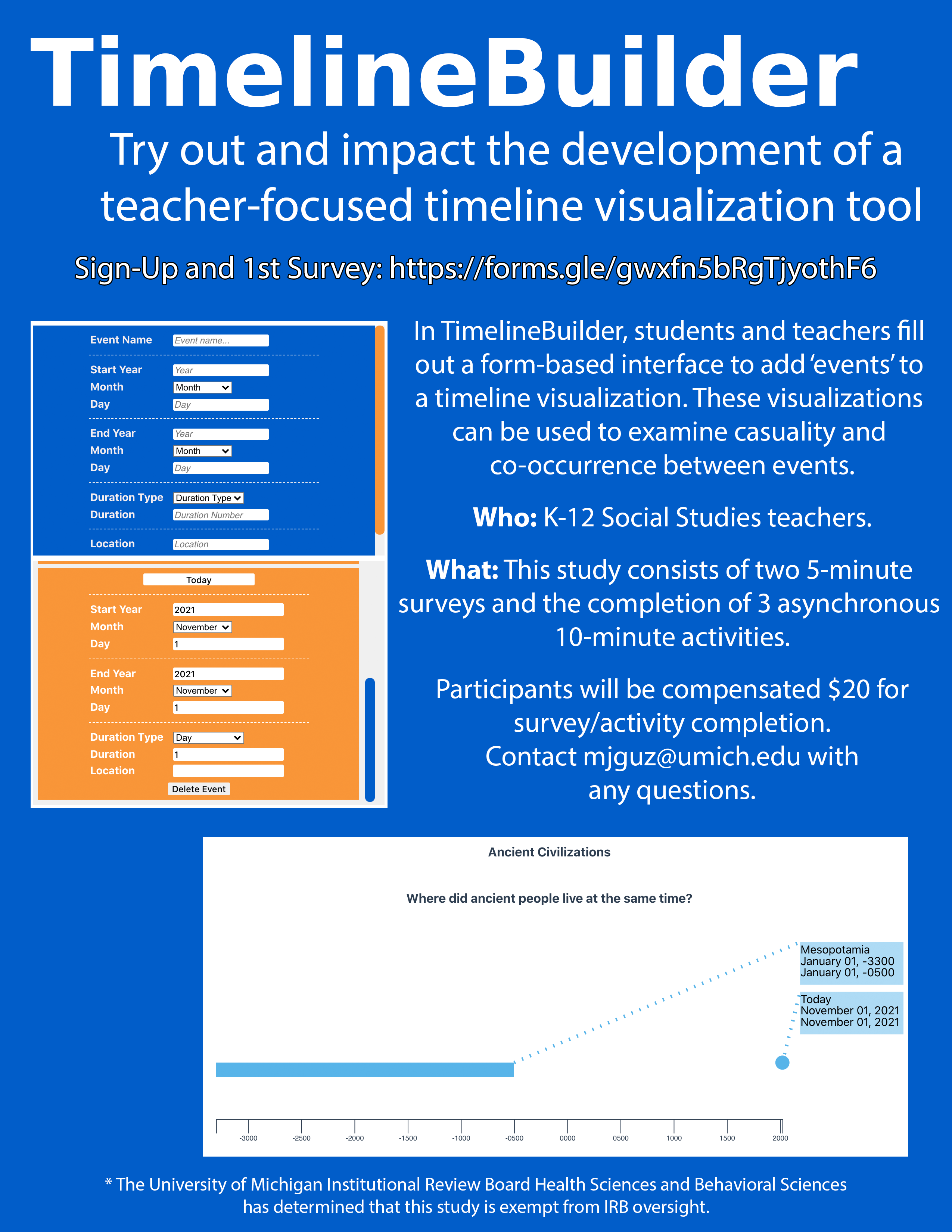
DV4L Scripting Study
Through our work with social studies educators thus far, we have designed the tools DV4L-Basic and DV4L-Scripting specifically to support data literacy standards in social studies classrooms. If you are a social studies middle or high school teacher, we would love to hear your feedback. If you can spare less than an hour of your time to participate in our study, we will send you a $50 gift card for your time and valuable feedback.
If you are interested but want more details, please visit/complete the consent form here: https://forms.gle/yo3yWGThQ1wnhu7g7
For questions or concerns, please contact Mark Guzdial (mjguz@umich.edu) or Bahare Naimipour (baharen@umich.edu).
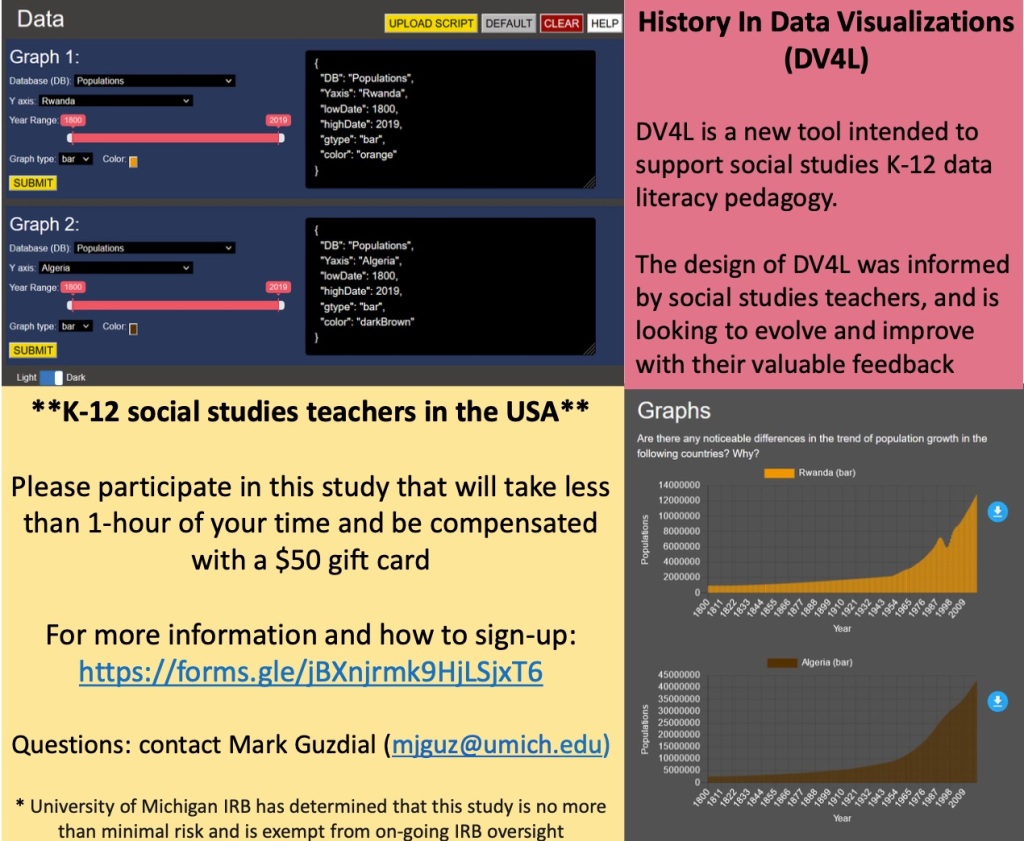
References
Guzdial, M. and Tamara L. Shreiner. 2021. “Integrating Computing through Task-Specific Programming for Disciplinary Relevance: Considerations and Examples.” In Computational Thinking in Education: A Pedagogical Perspective, Aman Yadav and Ulf Dalvad Berthelsen (Eds). PDF of Submitted.
Shreiner, Tamara L., Mark Guzdial, and Bahare Naimipour. 2021. “Using Participatory Design Research to Support the Teaching and Learning of Data Literacy in Social Studies.” Presented at CUFA, the College and University Faculty Assembly 2021 of the National Council of the Social Studies. PDF
Computer Science was always supposed to be taught to everyone, and it wasn’t about getting a job: A historical perspective
I gave four keynote talks in the last two months, at SIGITE, Models 2021 Educators’ Symposium, VL/HCC, and CSERC. I’m honored to be invited to them, but I do suspect that four keynotes in six weeks suggest some “personal issues” in planning and saying “No.” Some of these were recorded, but I don’t believe that any of them are publicly available
The keynotes had a similar structure and themes. (A lot easier than four completely different keynotes!) My activities in computing education these days are organized around two main projects:
- Defining computing education for undergraduates in the University of Michigan’s College of Literature, Science, and Arts (see earlier blog post referencing this effort);
- Participatory design of Teaspoon languages (mentioned most recently in this blog post).
My goal was to put both of these efforts in a historical context. My argument is that computer science was originally invented to be taught to everyone, but not for economic advantage. I see the LSA effort and our Teaspoon languages connected to the original goals for computer science. The talks were similar to my SIGCSE 2019 keynote (blog post about that talk here, and video version here), but puts some of the early history in a different perspective. I’m not going to go into the LSA Computing Education effort or Teaspoon languages here. I’m writing this up because I hope that it’s a perspective on the early history that might be useful to others.
I start out with C.P. Snow.

My PhD advisor, Elliot Soloway, would have all of his students read this book, “The Two Cultures.” Snow was a scientist who bemoaned the split between science and humanities in Western culture. Snow mostly blamed the humanities. That wasn’t Elliot’s point for having us read his book. Elliot wanted us to think about “Who could use what we have to teach, but might not even enter our classroom?”

This is George Forsythe. Donald Knuth claims that George Forthye first published the term “computer science” in a paper in the Journal of Engineering Education in 1961. Forsythe argued (in a 1968 article) that the most valuable parts of a scientific or technical education were facility with natural language, mathematics, and computer science.

In 1961, the MIT Sloan School held a symposium on “Computers and the World of the Future.” It was an amazing event. Attendees included Gene Amdahl, John McCarthy, Alan Newell, and Grace Hopper. Martin Greenberger’s book in 1962 included transcripts of all the lectures and all the discussants’ comments.

C.P. Snow’s chapter (with Norbert Wiener of Cybernetics as discussant) predicted a world where software would rule our lives, but the people who wrote the software would be outside the democratic process. He wrote, “A handful of people, having no relation to the will of society, having no communication with the rest of society, will be taking decisions in secret which are going to affect our lives in the deepest sense.” He argued that everyone needed to learn about computer science, in order to have democratic control of these processes.
In 1967, Turing laureate Peter Naur made a similar argument (quoting from Michael Caspersen’s paper): “Once informatics has become well established in general education, the mystery surrounding computers in many people’s perceptions will vanish. This must be regarded as perhaps the most important reason for promoting the understanding of informatics. This is a necessary condition for humankind’s supremacy over computers and for ensuring that their use do not become a matter for a small group of experts, but become a usual democratic matter, and thus through the democratic system will lie where it should, with all of us.” The Danish computing curriculum explicitly includes informing students about the risks of technology in society.
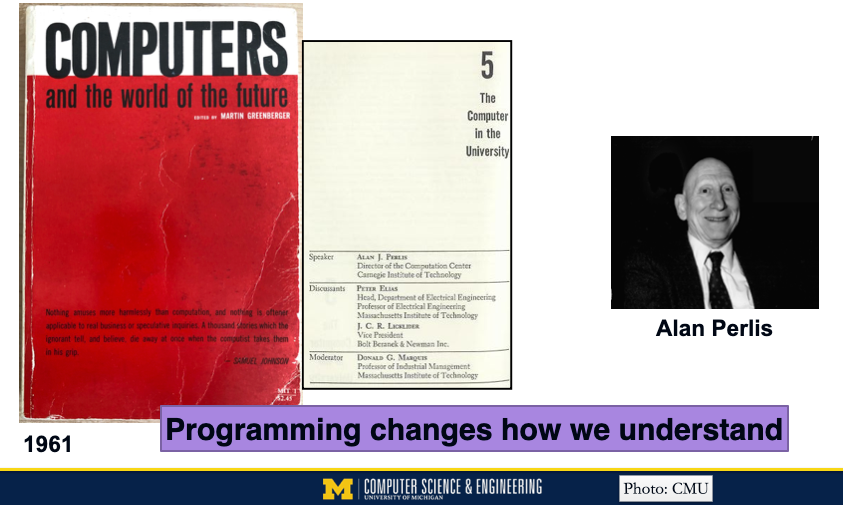
Alan Perlis (first ACM Turing Award laureate) made a different argument in his chapter. He suggested that everyone at University should learn to program because it changes how we understand everything else. He argued that you can’t think about integral calculus the same after you learn about computational iteration. He described efforts at Carnegie Tech to build economics models and learn through simulating them. He was foreshadowing modern computational science, and in particular, computational social science.
Perlis’s discussants include J.C.R. Licklider, grandfather of the Internet, and Peter Elias. Michael Mateas has written a fascinating analysis of their discussion (see paper here) which he uses to contextualize his work on teaching computation as an expressive medium.

In 1967, Perlis with Herb Simon and Alan Newell published a definition for computer science in the journal Science. They said that CS was “the study of computers and all the phenomena surrounding them.” I love that definition, but it’s too broad for many computer scientists. I think most people would accept that as a definition for “computing” as a field of study.
Then, we fast forward to 2016 when then-President Obama announced the goal of “CS for All.” He proposed:
Computer science (CS) is a “new basic” skill necessary for economic opportunity and social mobility.
I completely buy the necessity part and the basic skill part, and it’s true that CS can provide economic opportunity and social mobility. But that’s not what Perlis, Simon, Newell, Snow, and Forsythe were arguing for. They were proposing “CS for All” decades before Silicon Valley. There is value in learning computer science that is older and more broadly applicable than the economic benefits.

The first name that many think of when talking about teaching computing to everyone is Seymour Papert. Seymour believed, like Alan Perlis, “that children can learn to program and learning to program can affect the way that they learn everything else.”
The picture in the lower right of this slide is important. On the right is Gary Stager, who kindly shared this picture with me. On the left is Wally Feurzeig who implemented the programming language Logo with Danny Bobrow, when Seymour was a consultant to their group at BBN. In the center is Cynthia Solomon who collaborated with Seymour on the invention of the Turtle (originally a robot, seen at the top) and the development of Logo curriculum.
Cynthia was the lead author of a recent paper describing the history of Logo (see link here), which included the example of early Logo use on the upper right of this slide, which generates random sentences. Logo is named for the Greek word logos for “word.” The first examples of Logo were about manipulating natural language. Logo has always been used as an expressive medium (music, graphics, storytelling, and animation), as well as for learning mathematics (see the great book Turtle Geometry).
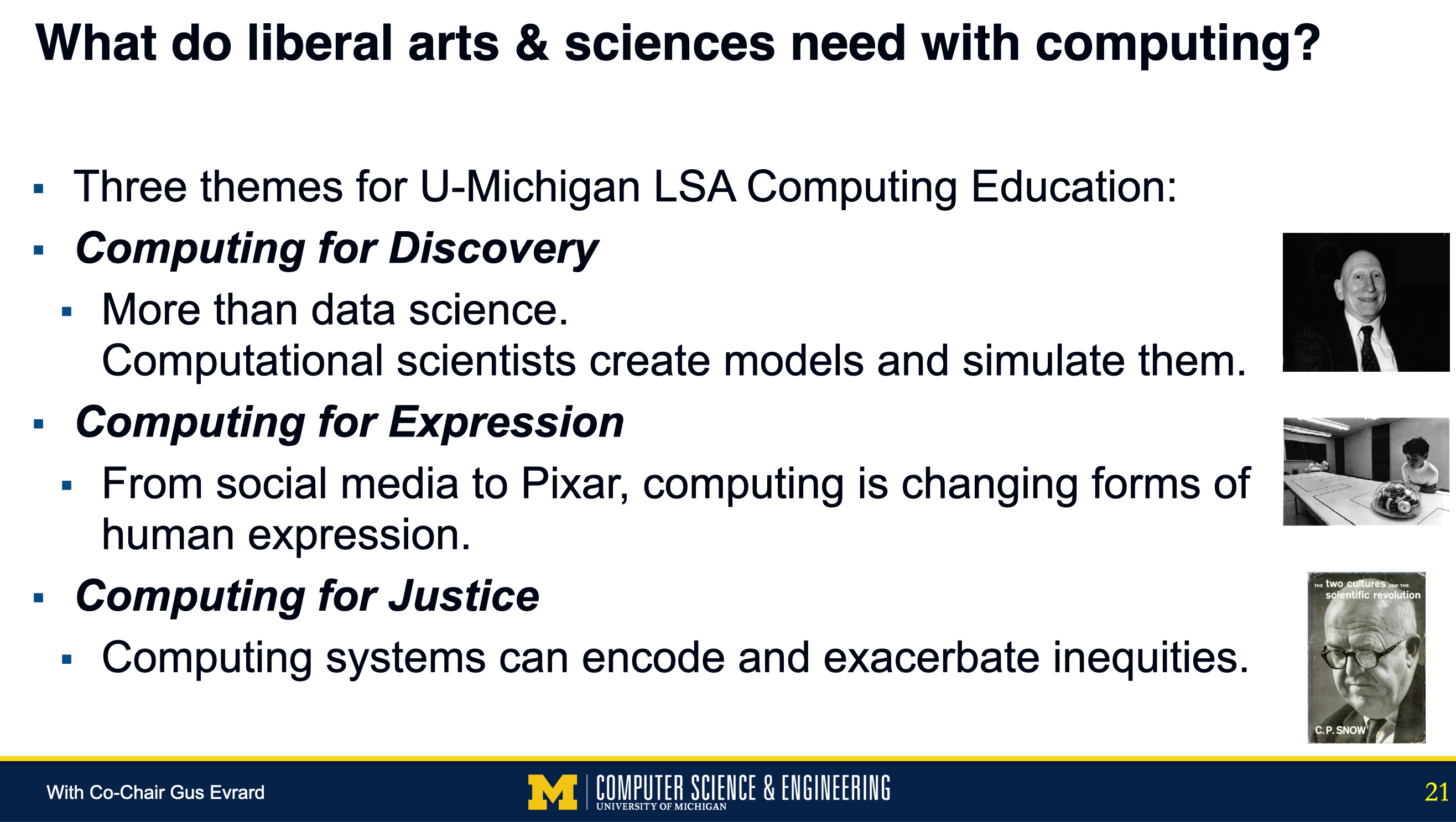
This is the context in which I think about the work with the LSA Computing Education Task Force. Our question was: At an R1 University with a Computer Science & Engineering undergraduate degree and an undergraduate BS in Information (with tracks in information analysis and user experience (UX) design), what else might undergraduates need? What are the purposes for computing that are broader and older than the economic advantages of professional software development? We ended up defining three themes of what LSA faculty do with computing and what they want their students to know:
- Computing for Discovery – LSA computational scientists create models and simulate them (not just analyze data that already exists), just as Alan Perlis suggested in 1961.
- Computing for Expression – Computing has created new ways for humans to express themselves, which is important to study and to use to explore, invent, and create new forms of expression, as the Logo community did starting in the 1960’s.
- Computing for Justice – LSA scholars investigate how computing systems can encode and exacerbate inequities, which requires some understand of computing, just as C.P. Snow talked about in 1961.
We develop our Teaspoon languages to meet the needs of teachers in teaching non-CS and even non-STEM classes. We argue that there are computing education learning objectives that we address with Teaspoon languages, even if they don’t include common languages features like for, while, and if statements. A common argument against our work in Teaspoon languages is that we’re undertaking a Sisyphean task. Computing is what it is, programming languages are what they are, and education is not going to be a driving force for changing anything in computing.
And yet, that’s exactly how the desktop user interface was invented.

Alan Kay (another Turing laureate in this story), Adele Goldberg, and Dan Ingalls led the development of Smalltalk in Xerox PARC in the 1970’s. The goal for Smalltalk was to realize Alan’s vision of a Dynabook, using the computer as a tool for learning. The WIMP (overlapping Windows, Icons, Menus, and mouse Pointer) interface was invented in order to achieve computing education goals. For the purposes of education, the user interface that you are using right now was invented.
The Smalltalk work tells us that we don’t have to accept computing as it is. Computing education today focuses mostly on preparing students to be professional software developers, using the tools of professional software development. That’s important and useful, but often eclipses other, broader goals for learning computing. The earliest goals for computing education are different from those in most of today’s computing education. We should question our goals, our tools, and our assumptions. Computing for everyone is likely going to look different than the computing we have today which has been defined for a narrow set of goals and for far fewer people than “all.”
Media Computation today: Runestone, Snap!, Python 3, and a Teaspoon Language
I don’t get to teach Media Computation1 since I moved to the University of Michigan, so I haven’t done as much development on the curriculum and infrastructure as I might like if I were teaching it today. I did get a new version of JES (Jython Environment for Students) released in March 2020 (blog post here), but have rarely even started JES since then.
But using Jython for Media Computation is so 2002. Where is Media Computation going today?
I’ve written a couple of blog posts about where Media Computation is showing up outside of JES and undergraduate CS. Jens Moenig has been doing amazing things with doing Media Computation in Snap! — see this blog post from last year on his Snap!Con keynote talk. SAP is now offering a course From Media Computation to Data Science using Snap! (see link here). Barbara Ericson’s work with Runestone ebooks (see an example blog post here) includes image manipulation in Python inside the browser at an AP CS Principles level (see example here). The amazing CS Awesome ebook that Beryl Hoffman and Jen Rosato have been doing with Barb for AP CS A includes in-browser coding of Java for the Picture Lab (see example here).
I was contacted this last January by Russ Tuck and Jonathan Senning. They’re at Gordon College where they teach Media Computation, but they wanted to do it in Python 3 instead of Jython. You can find it here. It works SO well! I miss having the image and sound explorers, but my basic demos with both images and sounds work exactly as-is, with no code changes. Bravo to the Gordon College team!

Most of my research these days is grounded in Task-Specific Programming languages, which I’ve blogged about here (here’s a thread of examples here and here’s an announcement of funding for the work in social studies). We now refer to the project as Teaspoon Computing or Teaspoon Languages — task-specific programming => TSP => Teaspoon. We’re adding a teaspoon of computing into other subjects. Tammy Shreiner and I have contributed a chapter on Teaspoon computing to a new book by Aman Yadav and Ulf Dalvad Berthelsen (see announcement of the book here).
We have a new Teaspoon language, Pixel Equations, that uses Media Computation to support an Engineering course in a Detroit Public School. Here, students choose a picture as input, then (1) enter the boolean equations for what pixels to select and (2) enter equations for new red, green, and blue values for those pixels. The conditionals and pixel loops are now implicit.
In several of our tools, we’re now exploring bilingual or multilingual interfaces, inspired by Sara Vogel’s work on translanguaging (see paper here) and Manuel Pérez-Quiñones’s recent work on providing interfaces for bilingual users (see his TED talk here and his ACM Interactions paper here). You can see in the screenshot below that colors can be referenced in either English or Spanish names. We’re now running participatory design sessions with teachers using Pixel Equations.
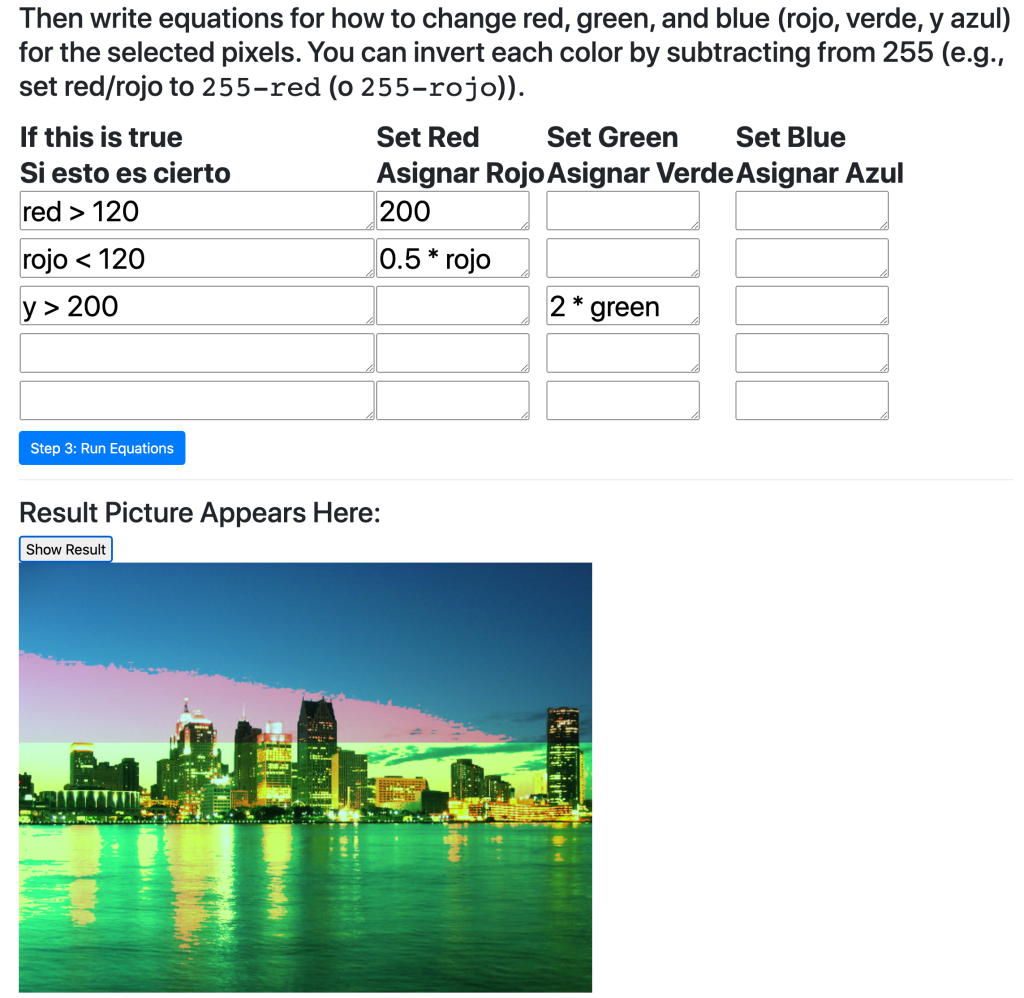
I’m planning a series of blog posts on all our Teaspoon languages work, but it’ll take a while until I get there.
- For new readers, Media Computation is a way of introducing computing by focusing on data abstractions used in digital media. Students write programs to manipulate pixels of a picture (to create photo filters), samples of a sound (e.g., to reverse sounds), characters of a text, and frames of a video (for video special effects). More at http://mediacomputation.org ↩
Recent Comments